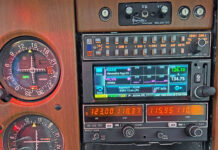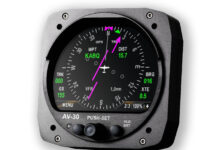This month’s panel for planning is a hypothetical one, spun off from reader Taylor Strack. He’s knee-deep in planning a Garmin avionics upgrade for his Cessna Skylane, considering Garmin’s GI 275 round-format flight instruments or the smaller version (7-inch portrait) of Garmin’s G500 TXi combination PFD/MFD. As an example, the smaller TXi is the display installed in the far right of the panel below. In that installation, the 7-inch G500 TXi is being used as a secondary display to contain Garmin’s EIS engine display system, plus it has a variety of MFD functions, including mapping.
For many—in hopes of saving some dough—thoughts turn to using that 7-inch version of the G500 TXi as the primary and one-and-only display for flight instruments and engine data, installed in the center of the pilot’s instrument panel. That can create a confusing dilemma because while the smaller display option is cheaper (the flagship 10-inch G500 TXi is $17,795 and the smaller 7-inch version is $13,995), there are some important limitations to understand, based on STC and FAA regulatory requirements that govern how primary data must be displayed.
In the case of Garmin’s EIS engine data that’s used as primary (replacing the OEM engine and fuel gauges, as an example), this primary data must be displayed full time, just as it has been for years and years on dedicated mechanical gauges. The same is true for the primary flight data that’s locked in place on any certified primary flight display. In other words, when a flight display is used as the primary one, the attitude, heading, airspeed and altitude data is locked and you can’t scroll off that main data page to access other features.
That’s why bigger is better
And when it comes to primary displays, bigger really is better because there’s simply more screen real estate to display all of the primary data that’s required to be visible to the pilot at all times.
In the case of Garmin’s 10-inch G500 TXi (and flagship big-screen G3X Touch), there’s enough room to indicate EIS engine and fuel data, plus the primary flight instrumentation. The 7-inch versions, though—not enough space. I suppose Garmin could have made the font smaller to cram all that data onto a small screen, but it just isn’t practical, and I doubt most pilots would be happy with it.
As for the smaller round-format GI 275 used as a primary flight display and EIS, there’s no getting away from having to install separate instruments—one for EIS engine and fuel data and another for flight instrumentation as shown on the two GI 275s pictured. Remember, too, that even the biggest primary flight display needs to be backed up by dedicated standby instruments. This can be an electronic all-in-one EFIS like a Garmin G5, GI 275 or even round mechanical instruments.
Got a panel that needs some planning? Send us some good photos and we’ll help noodle it.






